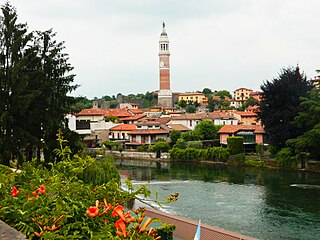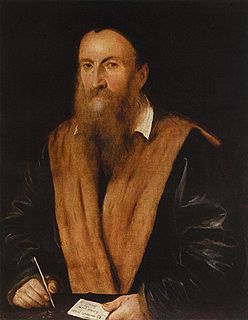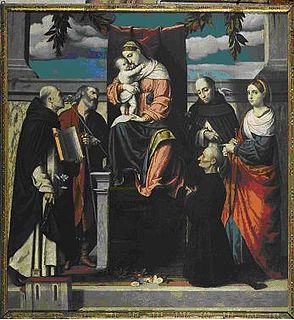
Domenico Carretti (c. 1650-c. 1719) was an Italian painter, born in Bologna, and active mainly at Brescia. He painted a Virgin with the Infant Jesus and St. Theresa for the church of San Pietro in Oliveto in Brescia.

Domenico Carretti (c. 1650-c. 1719) was an Italian painter, born in Bologna, and active mainly at Brescia. He painted a Virgin with the Infant Jesus and St. Theresa for the church of San Pietro in Oliveto in Brescia.

Alessandro Bonvicino, more commonly known as Moretto, or in Italian Il Moretto da Brescia, was an Italian Renaissance painter from Brescia, where he also mostly worked. His dated works span the period from 1524 to 1554, but he was already described as a master in 1516. He was mainly a painter of altarpieces that tend towards sedateness, mostly for churches in and around Brescia, but also in Bergamo, Milan, Verona and Asola; many remain in the churches they were painted for. Most are on canvas, but a number even of large ones are on wood panel. Only a handful of drawings survive.

Palazzolo sull'Oglio is a city and comune in the Province of Brescia, in the region of Lombardy in northern Italy. It is located south of Lake Iseo, bordering the Province of Bergamo, and has a population of 20,208. It is the fifth largest city in the Province, after Brescia, Desenzano del Garda, Montichiari and Lumezzane.

Brescia Calcio, commonly referred to as Brescia, is an Italian football club based in Brescia, Lombardy, that currently plays in Serie B.

Vincenzo Foppa was an Italian painter from the Renaissance period. While few of his works survive, he was an esteemed and influential painter during his time and is considered the preeminent leader of the Early Lombard School. He spent his career working for the Sforza family, Dukes of Milan, in Pavia, as well as various other patrons throughout Lombardy and Liguria. He lived and worked in his native Brescia during his later years.

Girolamo Savoldo, also called Girolamo da Brescia was an Italian High Renaissance painter active mostly in Venice, although he also worked in other cities in northern Italy. He is noted for his subtle use of color and chiaroscuro, and for the sober realism of his works, which are mostly religious subjects, with a few portraits. His portraits are given interest by their accessories or settings; "some even look like extracts from larger narratives".

Girolamo Romani (Romanino) was an Italian High Renaissance painter active in the Veneto and Lombardy, near Brescia. His long career brought forth several different styles.

Andrea Celesti (1637–1712) was an Italian painter of the Baroque period, working in Venice. His style gravitated over the years from a turgid and academic weightiness to a lighter, looser brushstroke.

Lattanzio Gambara was an Italian painter, active in Renaissance and Mannerist styles. It is likely that Gambara is the same 16th century painter referred to as Lattanzio Cremonese or Lattanzio da Cremona.

Floriano or Fioravante Ferramola was an Italian painter of the Renaissance period, active mainly in Brescia.

Domenico Bruni was an Italian painter of the Baroque period, mainly active in Brescia.

Francesco Paglia was an Italian painter of the late-Baroque period, mainly active in Brescia.

Camillo Rama was an Italian painter, active in his native city of Brescia.
Andrea Torresani was an Italian painter of the Baroque period, active in his native city of Brescia, Milan, and Venice.
Brescia or da Brescia is a surname derived from the city of Brescia in Italy. Notable people with the surname include:
Paolo Caylina the Younger was a 16th-century Italian painter active mainly in Brescia in a Renaissance style.

Brescia is a city and comune in the region of Lombardy, Northern Italy. It is situated at the foot of the Alps, a few kilometers from the lakes Garda and Iseo. With a population of more than 200,000, it is the second largest city in the administrative region and the fourth largest in northwest Italy. The urban area of Brescia extends beyond the administrative city limits and has a population of 672,822, while over 1.5 million people live in its metropolitan area. The city is the administrative capital of the Province of Brescia, one of the largest in Italy, with over 1,200,000 inhabitants.

Enthroned Madonna and Child with Saint James the Great and Saint Jerome is a c.1517 oil on canvas painting by Moretto da Brescia, now in the High Museum of Art in Atlanta, which acquired it in 1950. It is one of the painter's earliest known works.

Madonna and Child with Saint Martin and Saint Catherine is an oil on canvas painting by Moretto da Brescia, executed c. 1530, now on the high altar in the church of San Martino in Porzano, Province of Brescia. It is the painter's first mature work and forms an important step towards his Coronation of the Virgin Altarpiece.

The Orzinuovi Altarpiece or Enthroned Madonna and Child with Saints Dominic, Joseph, Vincent Ferrer, Lucy and a Commissioner is a 1525–1530 oil on canvas painting by Moretto da Brescia on the wall of the chancel of the church of San Domenico in Orzinuovi.

St Justina of Padua with a Donor is an oil on panel painting by Moretto da Brescia, executed c. 1530, now in the Kunsthistorisches Museum in Vienna, to which it was transferred in the late 19th century soon after the Museum's opening. It shows Justina of Padua.